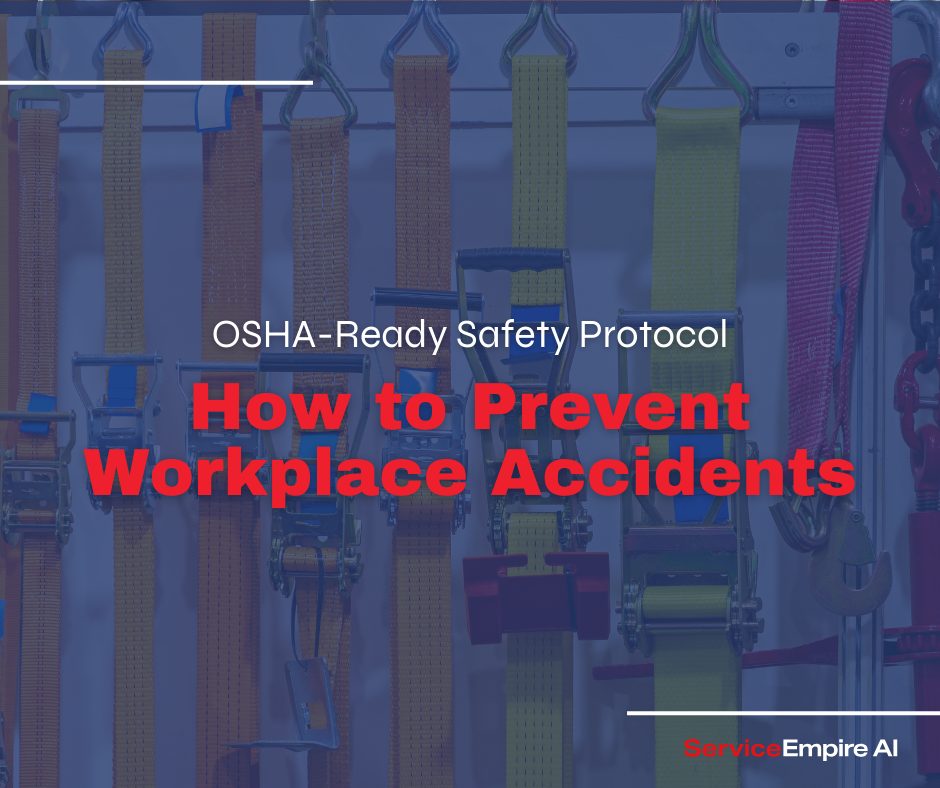
Creating a safe workplace isn't only about following rules—it's about protecting your team and your business. Here's how to build a safety protocol that actually works.
Risk Assessment Fundamentals
Start by mapping out every area where work happens. If you're a residential field service company, start with a list of the things every home has: driveway, kitchen, bathroom, etc. Then, make a list of special areas that some homes have, but some homes don't. Think: basement, swimming pool, garage or pole barn, etc.
Look at each space through a safety lens: what could go wrong here? Consider everything from slip and trip hazards to equipment risks. Create a simple rating system that helps prioritize the biggest risks first.
The key is to involve your whole team in identifying hazards. They often spot risks that managers might miss. Make it easy for anyone to report potential hazards as you're building the lists.
And if a near-miss incident happens, allow employees to report them without fear of criticism. Celebrate that it was a near-miss, then figure out how you can prevent that being an accident tomorrow if not addressed.
Safety Protocol Development
Your safety protocols need to be crystal clear and easy to follow. Start with the basics: proper equipment use, required safety gear, and emergency procedures. Write these in plain language that everyone can understand. Focus on the why behind each rule. People follow safety protocols better when they understand the reasoning.
Personal protective equipment (PPE) requirements should be specific to each task. Make it obvious what gear is needed for different jobs. More importantly, make that gear easy to access. The best safety equipment in the world won't help if it's locked in a storage room across the building and isn't actually in their truck that they drive to each site.
Documentation and Inspections
Good documentation protects everyone. Keep clear records of safety training, equipment maintenance, and any incidents or near-misses. Use simple forms that capture essential information without creating unnecessary paperwork. Photos can be especially helpful for documenting both hazards and proper safety setups.
Create a safety checklist that your field service technicians can use on every job site. If they go to 2-3 businesses per day, or 4-6 different homes per day, these checks will become second nature quickly.
Create a system for regular safety inspections too. Document what's checked, when, and by whom. Follow up on any issues found and record when they're resolved. This creates a clear trail of your commitment to workplace safety.
Where to Start
Start with comprehensive training for all team members. Cover both general safety principles and job-specific hazards. Make training engaging and practical. Show proper techniques, let people practice with safety equipment, and encourage questions.
Regular refresher sessions keep safety top of mind. These don't need to be long—even short toolbox talks can be effective. Share real examples from your workplace and industry. Learning from others' experiences can prevent similar incidents.
Celebrate Success
Track safety metrics. Every company has to track incident rates to stay compliant with OSHA. But you can take safety a step further by looking at leading indicators like near-miss reports, safety suggestions, and on-going training. These tell you how well your prevention efforts are working.
Celebrate safety successes. When you reach safety milestones or see team members going above and beyond with safety practices, recognize those achievements. Maybe you buy t-shirts if you go a full year without a lost-time accident. This type of recognition reinforces that safety is a core company value.
Continuous Improvement
Review your safety protocols regularly. Are they working as intended? Are there new risks that need addressing? Use feedback from your team to make improvements and prevent workplace accidents. Sometimes small adjustments can make a big difference in both safety and efficiency.
Stay current with industry safety standards and best practices. What worked well last year might need updating as new equipment or procedures are introduced. Make safety improvement a constant process, not a one-time effort.
Emergency Preparedness
Have clear plans for different types of emergencies. Everyone should know exactly what to do in case of fire, tornado, earthquake, injury, or other serious incidents. Practice these procedures —muscle memory matters in emergencies. Remember school fire drills and tornado drills? Remember P.A.S.S. with a fire extinguisher?
Keep emergency contact information and first aid supplies easily accessible. Check and update these at least quarterly. Make sure multiple team members are trained in emergency response so there's always someone ready to help. Each shift too!
Remember, good safety practices protect both your team and your business. Stay safe!





